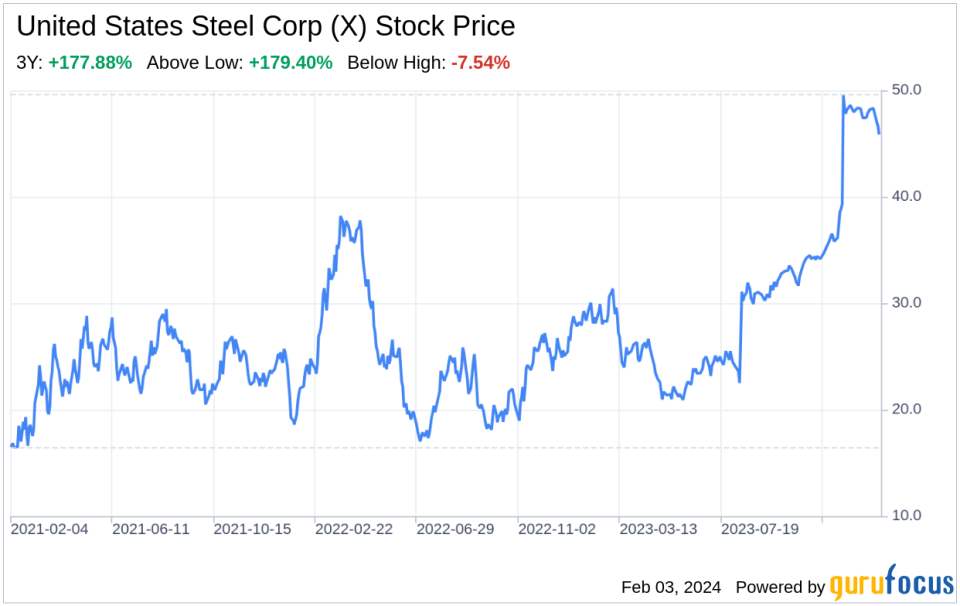Decoding United States Steel Corp (X): A Strategic SWOT Insight
United States Steel Corp (NYSE:X) stands as a significant player in the steel industry with a substantial production capacity and diverse market reach.
The company's recent merger agreement with Nippon Steel Corporation could signal strategic growth and expansion.
Despite facing cyclical industry challenges, U.S. Steel maintains a commitment to safety, environmental stewardship, and innovation.
Global overcapacity and international trade disputes continue to pose threats to the company's competitive standing.
On February 2, 2024, United States Steel Corp (NYSE:X) filed its 10-K report, revealing a year of strategic maneuvers and operational adjustments amidst a challenging market environment. As a titan in the steel industry, with a production capability of 22.4 million net tons and a presence across North America and Europe, U.S. Steel serves a diverse range of sectors, including automotive, construction, and energy. The company's financials reflect its robust operational footprint, with raw steel production averaging 71 percent of capability in 2023. Despite the idling of certain operations to align supply with demand, U.S. Steel's commitment to innovation and sustainability positions it as a forward-thinking leader in the market. This SWOT analysis delves into the strengths, weaknesses, opportunities, and threats as outlined in the latest SEC filing, providing investors with a comprehensive understanding of the company's strategic position.

Strengths
Strategic Partnerships and Market Position: United States Steel Corp (NYSE:X) has established a strong market position as the third largest U.S.-based steel producer and the twenty-seventh globally. The recent Merger Agreement with Nippon Steel Corporation underscores the company's strategic growth initiatives, potentially enhancing its global footprint and operational efficiencies. This partnership could lead to synergies that bolster U.S. Steel's competitive edge in high-margin markets and facilitate the adoption of innovative, low-carbon steelmaking technologies.
Operational Capacity and Diversification: The company's diverse operational segments, including Flat-Rolled, Mini Mill, U.S. Steel Europe (USSE), and Tubular Products, provide a broad production capability and a wide product range. With a significant annual raw steel production capacity and a high utilization rate, U.S. Steel demonstrates operational resilience. The Mini Mill segment, in particular, showcases the company's adaptability with its high-performance, sustainable steel production, serving key markets like automotive and construction.
Weaknesses
Market Sensitivity and Pricing Pressures: U.S. Steel's financial performance is highly sensitive to market fluctuations, as evidenced by the decline in segment results due to lower sales prices across most product categories. This vulnerability to cyclical industry dynamics and pricing pressures can impact profitability and necessitate operational adjustments, such as the idling of certain facilities to align with customer demand.
Dependence on Raw Material Supplies: The company's reliance on external sources for raw materials, including coking coal and natural gas, exposes it to supply chain risks and price volatility. While U.S. Steel has taken steps to secure adequate supplies at competitive prices, any disruptions or significant price increases could adversely affect production costs and margins.
Opportunities
Technological Advancements and Product Innovation: U.S. Steel's focus on applied research, development, and technical support functions positions it to capitalize on technological advancements and create innovative, value-added products. The company's commitment to environmental stewardship and the development of sustainable steelmaking processes aligns with global trends toward reducing carbon footprints, presenting opportunities for market differentiation and growth.
International Trade Developments: The company's active role in addressing global steel overcapacity and unfair trade practices through legal and regulatory channels could lead to a more favorable trade environment. The potential expiration of the European Commission's safeguard on global steel imports in June 2024 may open up new market opportunities for U.S. Steel, provided that the company can navigate the complex international trade landscape effectively.
Threats
Global Overcapacity and Competition: The steel industry's cyclical nature and global overcapacity present ongoing threats to U.S. Steel's market position. With overcapacity estimated to be over six times the entire U.S. steel market, the company faces intense competition from both integrated and electric arc furnace producers, as well as alternative materials like aluminum and composites.
Regulatory and Environmental Challenges: U.S. Steel must navigate a complex regulatory environment, including compliance with environmental standards and trade policies. The Section 232 tariffs and potential changes in trade agreements require strategic responses to mitigate impacts on the company's operational and financial performance. Additionally, environmental compliance costs and the need for continuous innovation in sustainable practices are critical factors that could influence the company's long-term viability.
In conclusion, United States Steel Corp (NYSE:X) exhibits a robust market presence and operational capacity, underpinned by strategic partnerships and a commitment to innovation. However, the company must contend with market sensitivity, raw material dependencies, and intense global competition. Opportunities for growth lie in technological advancements and favorable trade developments, while regulatory and environmental challenges pose significant threats. As U.S. Steel navigates these dynamics, its strategic decisions will be pivotal in shaping its future trajectory in the steel industry.
This article, generated by GuruFocus, is designed to provide general insights and is not tailored financial advice. Our commentary is rooted in historical data and analyst projections, utilizing an impartial methodology, and is not intended to serve as specific investment guidance. It does not formulate a recommendation to purchase or divest any stock and does not consider individual investment objectives or financial circumstances. Our objective is to deliver long-term, fundamental data-driven analysis. Be aware that our analysis might not incorporate the most recent, price-sensitive company announcements or qualitative information. GuruFocus holds no position in the stocks mentioned herein.
This article first appeared on GuruFocus.
